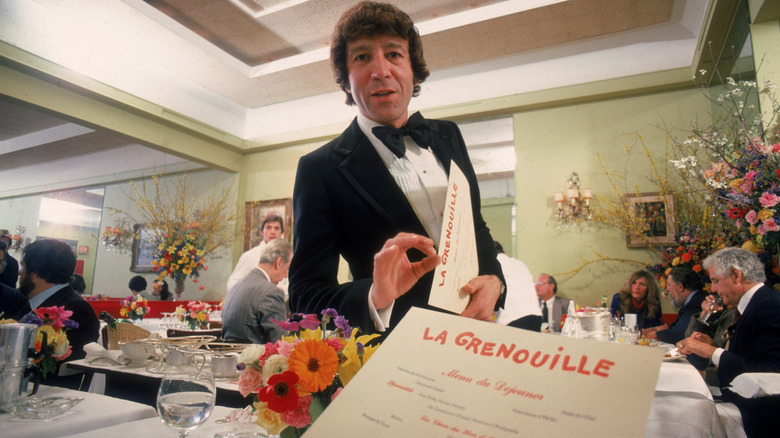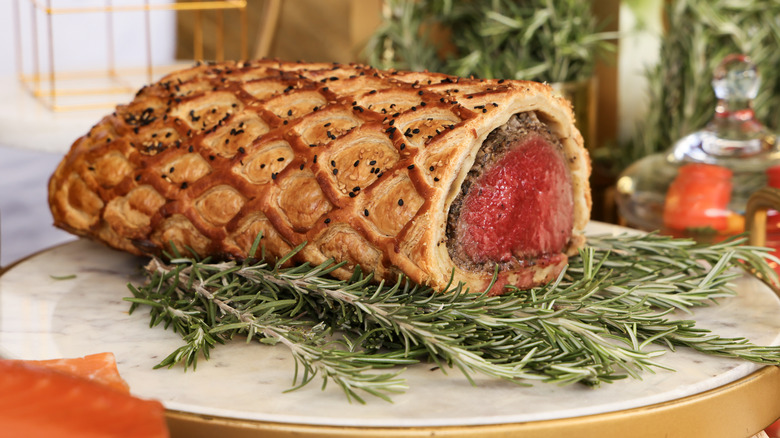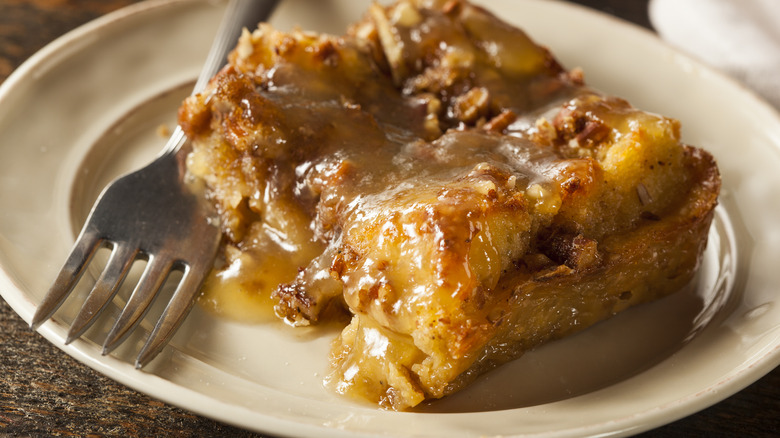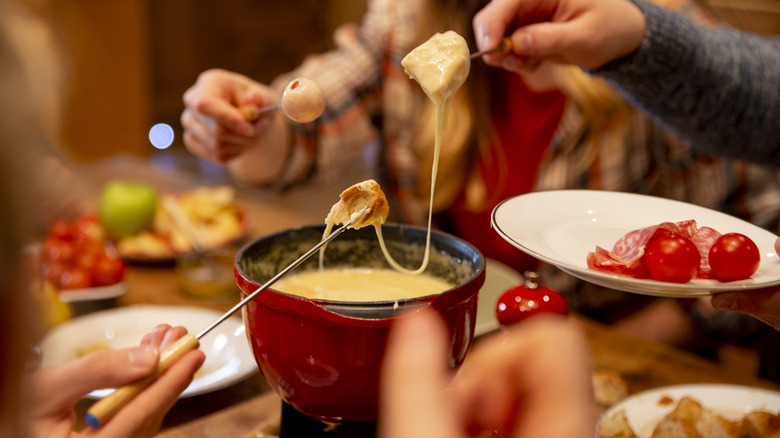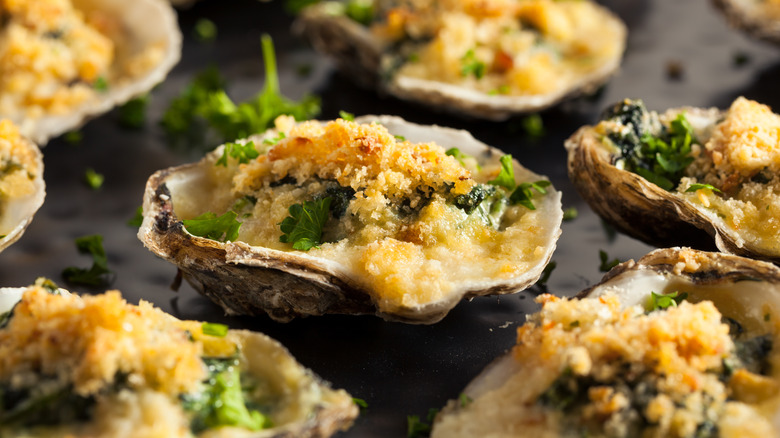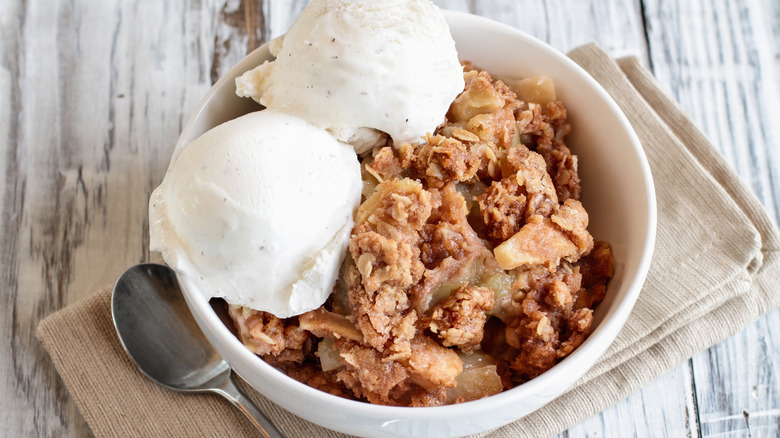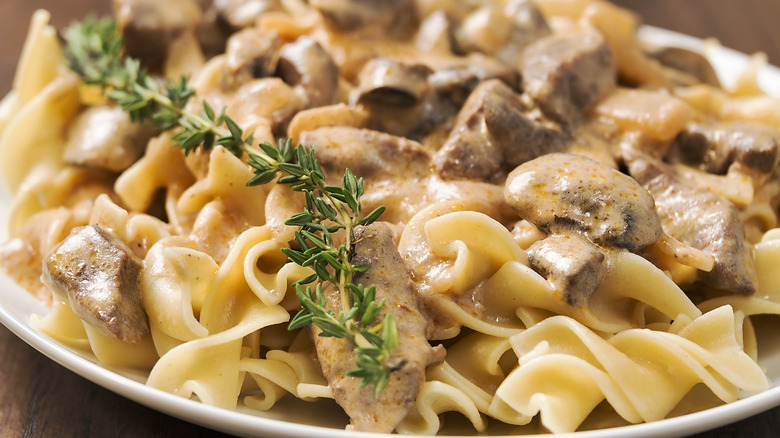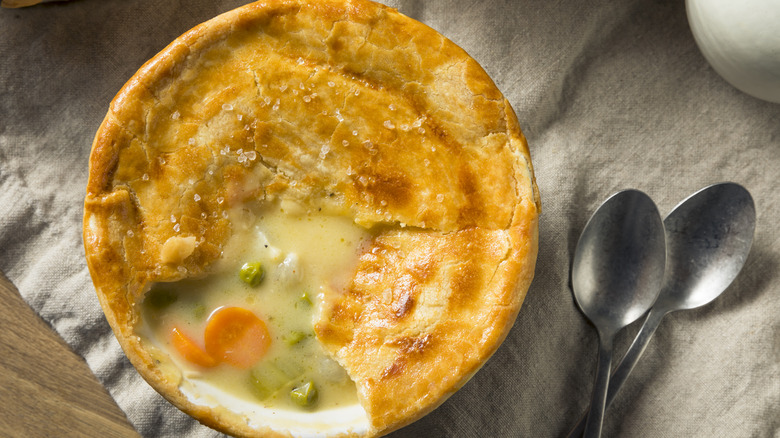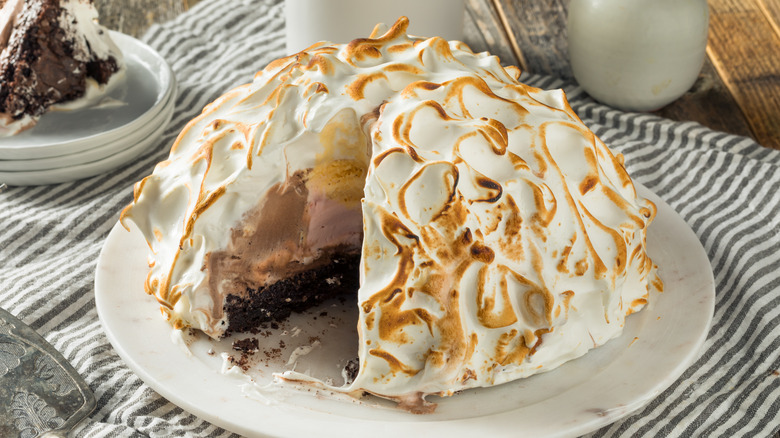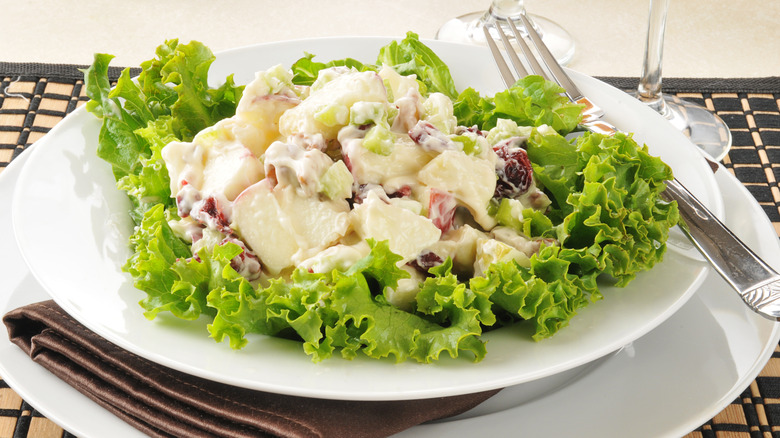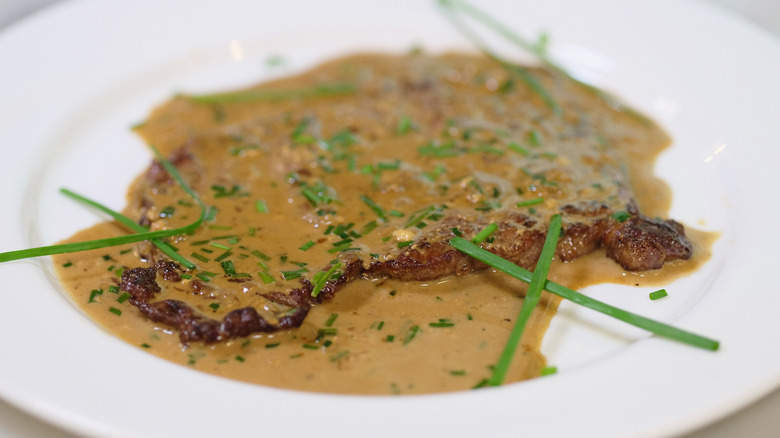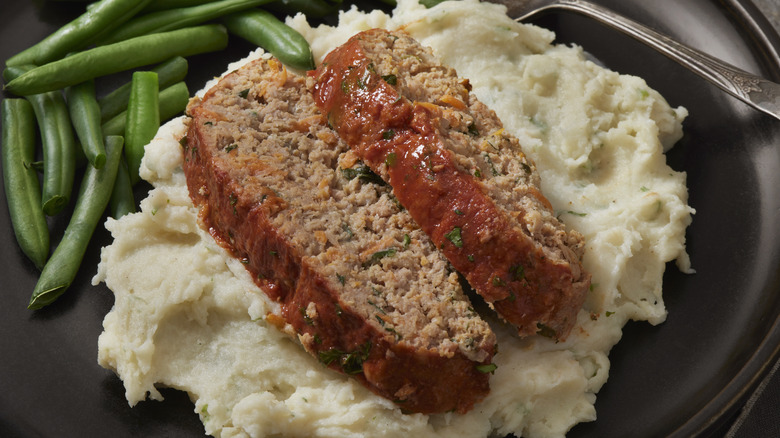14 Old-Fashioned Restaurant Dishes That Should Return
There's a cornucopia of reasons why we no longer see processed meat suspended in gelatin as a main course, or chowders of protected species under the soup of the day. We have evolved to cater to the contemporary palate, even if it's one that prefers lace-thin smash burgers and loaded Bloody Marys. Still, these formerly-mainstream dishes gently tug on our heartstrings. These old-fashioned restaurant dishes were around for years — that is, until they weren't. But is it time they get a reboot on modern menus? In fact, we think these throwback favorites should absolutely return as Today's Special.
So, which restaurant fare is primed for a 21st century takeover? From appetizers, to main courses and desserts, we're tapping the comments section and the annals of sit-down dining history for the dishes that we'd love to see back in regular rotation.
Beef Wellington
Where's the beef? When it comes to beef Wellington, you'll find it as a tender, center-cut tenderloin, adorned with a minced mushroom coating, wrapped up in a golden brown, flaky, pastry jacket. These days, you might run into its distant cousin, deconstructed as a 'shroom burger on brioche, but there was a time when beef Wellington was the fanciest thing since sliced bread.
As for its origin story, the Wellington name may have come from a dish created for the First Duke of Wellington. But we might not even be talking about beef Wellington if it weren't for the iconic Julia Child who published the recipe in her cookbook "Mastering The Art of French Cooking." She described it as, "A remarkably handsome, sumptuous dish when properly made."
According to Child, a proper filet de boeuf en croûte featured foie gras as part of the mushroom mix. While we don't imagine that part making the cut on most contemporary menus (for a variety of reasons you can, you know, Google) what we do see is a seriously savory comfort food becoming a staple for the people. It's one of the hardest dishes to make from scratch, so we're two thumbs up on the restaurant version.
Chicken cordon bleu
We're bringing back the fanciest freakin' chicken of your childhood. Chicken cordon bleu elevates a classic boneless chicken breast by rolling it up with ham, Swiss cheese, and tangy Dijon. While it was also commonly made at home in the '70s, this former restaurant blue plate special deserves an encore on the regular menu.
This particular combo hit all the right notes with an early iteration dating back to 1940s Switzerland (That one had schnitzel with cheese). Once it hit the restaurant circuit, it was usually crafted with a thin-pounded chicken breast folded with ham and cheese, all pressed with breadcrumbs, then baked or fried to a golden brown.
This recipe can be accomplished at home, but as one aspiring cordon bleu redditor lamented, "Normally mine comes out empty, because by the time you get the chicken done, the cheese has melted and [run] out." Why not leave all the technical hassle to the pros and order this old favorite off the menu?
Bread pudding
This sweet dish is already staging a coup on the dessert menu. Bread pudding is traditionally made with day-old bread and a sweet custard. It's already made the list at upscale steakhouses, but it's begging to become a regular at your favorite spot.
Once called "poor man's pudding," this working class dish was first eaten in England, somewhere around 11th century. It was born as a final call for stale bread at a time when every scrap of food was utilized. It went on to become so popular in America, that it's commonly known as a Southern thing, a Northeast thing, and an everywhere-else thing, too.
Of course, the bread pudding of the 21st century has gotten a bougie makeover. These days, it's often baked with breads like brioche and challah, bedazzled with dried fruit, or smothered in caramel sauce and handcrafted ice cream. One Reddit fan called it "the best dessert ever invented," and when it's made well, we couldn't agree more.
Fondue
Why a tabletop pot of dippy cheese ever disappeared from the menu is a freak mystery that may never be solved. The combination of bubbling Swiss cheese and white wine, into which you dipped a bite-sized chunk of crusty bread with a cartoonishly long fork was a total winner. So what happened?
You can thank the Swiss, back in the 18th century, for the cheese fondue that landed stateside at the World's Fair in New York, 1964. Just a few years later, no gathering was complete without a hot crock of Gruyère. The shareable dish quickly found a home in a formal hospitality capacity. In fact, The Melting Pot restaurant — fully devoted to the art of the fondue party for roughly 50 years — is still thriving despite an industry side-eye toward the communal melted cheese situation.
As to why it lost its luster on the restaurant scene, we acknowledge that there's a definite health and wellness aspect at play when you consider an entire pot of cheese to be your dinner. Still, we'll make the case for fondue — or, should we call it fun-due? — in that it's all about bringing people together over a shared pot o' gold. All in, it's just another of our favorite retro food trends that are due for a comeback.
Deviled eggs
Deviled eggs may be a dark horse on this list, but we'd also bet that it's secretly a favorite appetizer of yours, or someone you know. Ask around, because for many people, hard-boiled eggs that have been scooped out and re-stuffed with their own yolks beat newer apps like cheesy Brussels sprouts any day of the week.
Considering how much we love food that's been hollowed out and reworked into an even better version of itself (we're thinking of twice-baked potatoes, lobster thermidor, and stuffed crab), it's no wonder someone thought of doing the same with eggs. The custom of seasoning boiled eggs and plating them as an actual dish began in Ancient Rome. A more familiar-looking stuffed egg that featured an herby yolk-based mixture then popped up in the Middle Ages, with the Brits eventually calling out the seasoning process as "deviling." (Some cooks have been known to refer to the dish as "salad eggs" or "dressed eggs" to keep any red horns and pointy tails at bay.) Either way, add a sprinkle of paprika, and it was a home run for eggs.
We've already seen deviled eggs on small-plate menus. But as for the greater society of hard-boiled egg lovers goes, that's merely the beginning. America loves deviled eggs — now with yolk mixtures featuring avocado, crab, bacon, or pimento cheese — and it's high time they appear on restaurant menus across the nation.
Oysters Rockefeller
Perhaps the most famous of oyster dishes with last names, oysters Rockefeller deserves a Great Gatsby-style welcome back to brick-and-mortar establishments. These oysters get the luxe treatment with a buttery, herbaceous bread crumb mix, and a sizzling spin under the broiler. (If only they knew how delicious they are with a splash of lemon and hot sauce.)
We humans have been eating oysters for 164,000 years. But it wasn't until the turn of the 20th century when restaurateur Jules Alciatore invented this dish in New Orleans. Topping his oysters with a rich, green, money-colored sauce, he channeled the most famous millionaire around — oil tycoon John D. Rockefeller — for the name. That original sauce recipe is still up for debate, but these days, the traditional dish features a blend of butter, herbs, spinach, shallots, garlic, and a hefty slosh of the anise-forward French liqueur, Pernod.
But while oysters on the half-shell are a dime a dozen at many modern restaurants (not adjusted for inflation), oysters Rockefeller hasn't quite dusted off its old-fashioned reputation. Is it uncivilized to eat an oyster that isn't swimming in pure brine? Do we harshly judge a breaded oyster, and yet happily deep fry everything else under the sun? We'll give you gluten-free bread crumbs for the modern palate, but we still think this OG dish deserves a second look.
Fruit crisp
Fruit crisp understood the assignment when it came to the textural play between sweet, syrupy fruit, and a crunchy, golden crumble. Featuring just about any filling — from cherry, to peach or strawberry rhubarb — this dessert comes from a humble recipe that couldn't be easier to bake. As for why we don't see it very often on the menu anymore? Maybe its understated simplicity is to blame.
In the United States, a first-of-its-kind apple crisp recipe first popped up in Good Housekeeping in the early 1900s — and the standard method hasn't changed much since then. Toss your fruit of choice with sugar, lemon juice, and cornstarch, then top it with dough-like bits of butter, sugar, flour, and oats — and bake until bubbly and browned. It's like a fruit pie, freed from the pie tin, but with all the sweet, crusty bits in prime position on top. Optional à la mode.
It's actually miraculous that apple crisp ever appeared in a magazine at all, considering that it's basically Dessert 101. That's like publishing a recipe for toast (okay, but have you tried it in the broiler?). We're guessing that fruit crisp lost its luster because it didn't pack the showmanship of, say, an ice cream sundae dripping with edible gold. But if we're judging by comfort and mouthfeel, this is one crowd-pleaser that can go the distance.
Beef Stroganoff
Give us the meaty noods. A shining example of the oft-beleaguered brownish-grayish food of days gone by, classic beef Stroganoff's hearty sirloin, mushroom gravy, and stick-to-your-ribs egg noodles deserve a returning spot on the menu. Plus, there's Worcestershire sauce in it. Who doesn't want to try and say that word?
There are dueling origin stories surrounding this dish, and each makes for excellent dinner party conversation. The Stroganoff Foundation claims it started with the elite Russian Count Pavel Stroganoff, who was born in France, and who directed his personal chef to blend the flavors of his favorite French and Russian cuisines. But the more fun one (if much less true) is the alleged story that it was the brainchild of Andre Dupont, a French chef who first made it for the elderly Russian Count Alexander Grigorievich Stroganoff — who could no longer chew his meals, due to his aged teeth. Fantastical tale or not, this French and Russian hybrid hit American menus in the '50s and '60s, to great acclaim — and then zero acclaim. We think it's time to bring it back.
Beef Stroganoff serves up protein-packed comfort in every bite. And with advances in modern science since the Stroganoffs were around, we're envisioning new gluten-free noodles, hanger steak in place of stew beef, and a dusting of truffles on top.
Pot pie
Continuing the comfort food crusade, we humbly suggest that pot pie return to its glory days on the restaurant circuit. Dessert pies have staked their claim, and it's about time a savory pie tin gets stuffed to the brim with a rich, well-seasoned gravy that's positively crowded with tender chicken and veggies.
With roots going back to the chicken pies of medieval England, the version we know today hit its stride in the United States in the 20th century. A recipe featuring thick, flat noodles and no crust first took shape in Lancaster, Pennsylvania, with the full-crusted version going mainstream with chicken or beef filling, all across the nation.
Having started out as a riff on a British import, pot pies are ripe and ready for modernization on today's restaurant menus. Linden restaurant in Los Angeles already serves up a pulled wagyu oxtail version, with A Pie Stop in Alaska cooking a different pot pie every day of the week. Michael Mina gives this dish a Las Vegas spin with a brandied lobster cream for its signature lobster pot pie. Think pot pie's too old school to be cool? Think again.
Liverwurst
This liver-based sausage is actually a highly nutritious addition to your lunch plate — with lots of vitamins, aminos, and minerals — even if it has yet to crack your top 10 favorite sandwiches. (Just give it time. And mustard, onions, and pickles.)
Liverwurst is basically unbranded Spam, but with the confident flair to take center stage on a charcuterie board. It's high brow/low brow eating, having first become a thing in ancient Europe, when crafty butchers thought of using leftover animal parts to make sausage. (We're not gonna go too far into the history of so-called mystery meat. You get the idea.) After the concept landed in America in the early 1900s, thanks to German Jewish immigrants, liverwurst fandom was born.
"A liverwurst sandwich with mustard is quite possibly the perfect lunch for me. It tastes somewhere between bologna and bacon, it's just such a rich flavor," noted one Redditor. Another agreeable voice chimed in, "It is heaven on bread. Nothing better. Ignore these savages." We like liverwurst for its savory flavor and its intriguingly polarizing presence. What better way to spice up the lunch menu than with a sandwich that satisfies the appetite and sparks a conversation.
Baked Alaska
It's time to bring back the dessert that epitomizes a sweet sense of occasion. Baked Alaska makes a sacred spectacle out of tender cake topped with ice cream, fluffy meringue, and tableside pyrotechnics. (The bigger the better when it comes to the torch for that whipped crust.)
Just like most of our favorite old-fashioned recipes, the debate about who really invented baked Alaska may never end. With credit going to a chef at Delmonico's, NYC, who called the dish "Alaska, Florida" because of the cold and hot elements, or chef Antoine Alciatore in New Orleans, it was definitely created as the United States officially welcomed the state of Alaska. Still, as quickly as it gained popularity in mid-century restaurants, it was snuffed out by ice cream-free cakes baked with en vogue red velvet.
In lieu of lighting our own kitchen aflame, let's leave the extravagant ice cream cake with optional flambé to the professionals. While you might find baked Alaska at a heritage steakhouse or American bistro, we'd love to see this one light up regular restaurant dinner service again.
Waldorf salad
Beat it, leafy greens — sweet, creamy salads are the wave of the future (again). While Ambrosia salad was clearly masquerading as a first course dessert, with fruit, marshmallows, whipped topping, and maraschino cherries, Waldorf salad served up a sort of retro sophistication, with mayo, celery, and walnuts giving "this actually counts as salad, right?" vibes.
The original Waldorf version, concocted for a charity event at New York City's newly opened Waldorf Astoria, in 1931, featured just three ingredients: Apples, celery, and mayonnaise. Considering its gilded pedigree, the salad quickly went viral, soon featuring additions like grapes, raisins, and, yes, marshmallows. But despite the salad's popularity at its namesake hotel, where the Waldorf salad was ordered an average of 55 times a day, the rest of the nation moved on to salads that weren't as rich and sweet.
Still, we think there's room for a revamped version of the OG. Served on a bed of greens, a fruit-forward salad with healthy fats and a little added protein could count as a meal at any restaurant.
Steak Diane
She wears pearls to the pickleball court, dons sunglasses indoors, and refers to her pants as "slacks." And she's steak Diane. This flashy dish was once prepared tableside, featuring a New York strip or tenderloin sautéed in a pan as hot as the surface of the sun, with garlic and shallots swimming in flaming Cognac.
The caramelizing effects of the popular mid-century flambé weren't lost on diners who dressed to be seen (by the light of their dinner on fire). But as the fiery trend died down in New York City, so did this dish which had fully relied on its looks to survive. Inspired by Diana, the Roman goddess of the hunt, steak Diane prep moved back into the kitchen, where it was almost lost from the menu completely.
Couldn't this dish use a modern makeover? Dear restaurants, bring back steak Diane and we promise not to wear stretchy pants and flip flops to dinner.
Meatloaf
Modern meatloaf is giving your mama's recipe a serious run for its money. Always tapping into a sense of nostalgia, the traditional brick-shaped recipe of ground beef, seasonings, and ketchup (or not) has been a classic American favorite for roughly 100 years. No wonder it feels like home.
Meatloaf got its start in the United States as a breakfast food in the late 1800s, gaining popularity during the Great Depression as a way to use up kitchen scraps. But, by the 1950s, meatloaf landed on the menu in almost every diner across the nation. It was so ubiquitous in American culture, that it became a common movie trope to depict working class families just trying to put dinner on the table. Then, the meatloaf went away.
We've seen high-end renditions featuring wagyu, and humble loaves that purport to be just like grandma's. Maybe this Redditor nailed it when they described the meatloaf situation as "Super un-chic, but delicious." That might be why we're jonesing for this oldie-but-goodie to return to the main menu, no matter what it looks like.
How we chose these old-fashioned restaurant dishes
We tapped subreddits, professional interviews, and actual encyclopedias to assemble and celebrate the finest former favorite restaurant dishes of humankind. Basically, anything that involved fire or old-timey comfort food was on the table (or should be).
Also, we considered modern dining trends that lean toward a heaping helping of nostalgia. Because good food should satisfy your appetite and soothe your soul.

